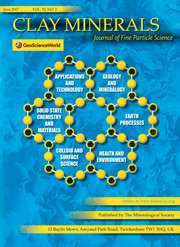Crossref Citations
This article has been cited by the following publications. This list is generated based on data provided by
Crossref.
McALEESE, D. M.
and
MITCHELL, W. A.
1958.
STUDIES ON THE BASALTIC SOILS OF NORTHERN IRELAND V. CATION‐EXCHANGE CAPACITIES AND MINERALOGY OF THE SILT SEPARATES (2–20μ).
Journal of Soil Science,
Vol. 9,
Issue. 1,
p.
81.
WILSON, M. J.
1966.
Weathered Biotite from Strathdon, Aberdeenshire.
Nature,
Vol. 210,
Issue. 5041,
p.
1188.
Wilson, M. J.
1966.
The weathering of biotite in some Aberdeenshire soils.
Mineralogical Magazine and Journal of the Mineralogical Society,
Vol. 36,
Issue. 276,
p.
1080.
Singer, Arieh
1967.
The argillation of sub-marine tufts from the Mount Carmel, Israel.
Clay Minerals,
Vol. 7,
Issue. 1,
p.
101.
Kautz, Karl
1969.
Laborversuche zum Abbau von Biotit.
Contributions to Mineralogy and Petrology,
Vol. 24,
Issue. 3,
p.
208.
Kolmer, H.
1971.
Zur Kaolinitbildung aus Biotit in oststeirischen Tuffen.
TMPM Tschermaks Mineralogische und Petrographische Mitteilungen,
Vol. 16,
Issue. 1-2,
p.
44.
Kapoor, B. S.
1972.
Weathering of micaceous clays in some Norwegian podzols.
Clay Minerals,
Vol. 9,
Issue. 4,
p.
383.
1973.
The Chemistry of Clay Minerals.
Vol. 15,
Issue. ,
p.
189.
Robert, M.
1973.
The Experimental Transformation of Mica Toward Smectite; Relative Importance of Total Charge and Tetrahedral Substitution.
Clays and Clay Minerals,
Vol. 21,
Issue. 3,
p.
167.
Pies, W.
and
Weiss, A.
1974.
References for III/7.
Vol. 7g,
Issue. ,
p.
80.
Huguenin, Robert L.
1974.
The formation of goethite and hydrated clay minerals on Mars.
Journal of Geophysical Research,
Vol. 79,
Issue. 26,
p.
3895.
Wilson, M.J.
and
Logan, J.
1976.
Exchange properties and mineralogy of some soils derived from lavas of lower o old red sandstone (devonian) age. I. Exchangeable Cations.
Geoderma,
Vol. 15,
Issue. 4,
p.
273.
Scheidegger, K.F.
and
Stakes, Debra S.
1977.
Mineralogy, chemistry and crystallization sequence of clay minerals in altered tholeiitic basalts from the Peru Trench.
Earth and Planetary Science Letters,
Vol. 36,
Issue. 3,
p.
413.
Wilson, M. J.
Bain, D. C.
and
Duthie, D. M. L.
1984.
The soil clays of Great Britain: II. Scotland.
Clay Minerals,
Vol. 19,
Issue. 5,
p.
709.
Wilson, M. J.
and
Nadeau, P. H.
1985.
The Chemistry of Weathering.
p.
97.
Pieper, G.
Pies, W.
and
Weiss, A.
1985.
Key Element: Si. Part 2.
Vol. 7d1b,
Issue. ,
p.
474.
Banfield, Jillian F.
and
Eggleton, Richard A.
1988.
Transmission Electron Microscope Study of Biotite Weathering.
Clays and Clay Minerals,
Vol. 36,
Issue. 1,
p.
47.
Dong, Hailiang
Peacor, Donald R
and
Murphy, Sheila F
1998.
TEM study of progressive alteration of igneous biotite to kaolinite throughout a weathered soil profile.
Geochimica et Cosmochimica Acta,
Vol. 62,
Issue. 11,
p.
1881.
Wilson, M. J.
1999.
The origin and formation of clay minerals in soils: past, present and future perspectives.
Clay Minerals,
Vol. 34,
Issue. 1,
p.
7.
Loveland, P. J.
Wood, I. G.
and
Weir, A. H.
1999.
Clay mineralogy at Rothamsted: 1934—1988.
Clay Minerals,
Vol. 34,
Issue. 1,
p.
165.


